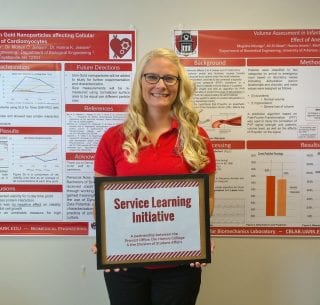Meet Professor Hanna Jensen! She is the clinical assistant professor at Biomedical Engineering. Her course BMEG 3801: Clinical Observations and Needs Funding has just been formally designated as service learning […]
 Meet Professor Hanna Jensen! She is the clinical assistant professor at Biomedical Engineering. Her course BMEG 3801: Clinical Observations and Needs Funding has just been formally designated as service learning course.
Meet Professor Hanna Jensen! She is the clinical assistant professor at Biomedical Engineering. Her course BMEG 3801: Clinical Observations and Needs Funding has just been formally designated as service learning course.
This course introduces students to the technical, professional, and ethical responsibilities of a biomedical engineer in the context of engineering product design and development. Students engage in team-based projects that they identify after completing clinical rotations in local medical facilities, clinics or hospitals. In the course of these projects, students engage the full scope of the engineering design process, with particular attention to clinical needs finding, problem definition, and preliminary design. Issues related to sustainability, bioethics, and health care economics are emphasized. In addition, students are introduced to the concepts of resource-constraint design, as well as important ethical considerations in the work of a biomedical engineer.
The Clinical Observations and Needs Finding course was instituted as a prerequisite to the Senior Design Project, with the goal of fostering innovation and product development that is directly relevant to local healthcare professionals and patients. Furthermore, the course prepares students to successfully identify, select and complete a project in the senior capstone course.
The main task for students in this course is to come up with an engineering project idea to directly improve patient care or the operation of a local clinic. This idea will be worked on in collaboration with local healthcare professionals.
The students are required to attend at least three 4-hour long observations in local healthcare settings. Based on these observations, they must come up with ideas on how their engineering skills can improve the operation of that clinic or hospital. The students are then required to write up a project idea as their midterm (which can be for example a device or a software), which addresses a gap they have observed in the clinic’s practice (this idea can be related to operation of clinic, work of physicians or other healthcare professionals, the experience of the patient or a caregiver etc. – any aspect of the clinic).
The students will then interact with clinic personnel via emails, teleconferences, and face-to-face meetings throughout the semester to make sure that the design prototype presented as final class assignment (Design Brief) describes an innovation that improves the operation of the clinic in a tangible way. The most relevant and feasible ideas coming from this class will then be selected by course instructor and relevant clinical partners for further development in the Senior Design Capstone course in the students’ senior year, during which they will actually build a working model of their design or software. This course thus fosters innovation and collaboration that is directly relevant for our local healthcare enterprise.
For this course, Dr. Jensen has a well-established collaboration with UAMS-NW and several other local clinics. Her students are tasked specifically to find areas of challenge in these environments, and propose solutions that they can provide. Thus all projects worked on the course will have a direct local need that this course is addressing. Projects are student-proposed and student-led, course instructor and clinical partners are available to provide guidance as needed. Dr. Jensen piloted this course this past spring with great feedback from students and clinical partners.
~~~~~~~~~~~~~~~~~~~~~~~~~~~~~~~~~~~~~~~~~~~~~~~~~~~~~~~~~~~~~~~~~~~~~~~~~~~~~~~~~~~~~
The university and the local newspaper did a nice write-up of the concept of this course, which can be viewed here:
- https://news.uark.edu/articles/41729/new-partnership-with-uams-offers-engineering-students-real-world-experience-through-clinical-rotations
- http://www.arkansasonline.com/news/2018/apr/15/biomedical-student-program-launches/